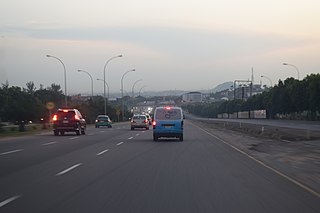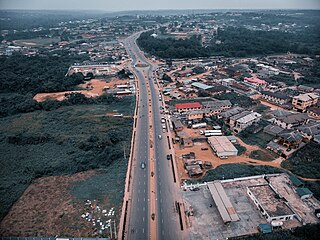
Transport in Ghana is accomplished by road, rail, air and water. Ghana's transportation and communications networks are centered in the southern regions, especially the areas in which gold, cocoa, and timber are produced. The northern and central areas are connected through a major road system.

Nigeria’s transport network has expanded in recent years to accommodate a growing population. The transport and storage sector was valued at N2.6trn ($6.9bn) in current basic prices in 2020, down from N3trn ($8bn) in 2019, according to the National Bureau of Statistics (NBS). This was reflected in a lower contribution to GDP, at 1.8% in the fourth quarter of 2020, down from 2.1% during the same period the previous year but higher than the 0.8% recorded in the third quarter of 2020. One of the most significant challenges facing the sector is meeting the needs of both large coastal cities and rural inland communities in order to fully unlock the country’s economic potential. This is especially the case with mining and agriculture, both of which are expected to benefit from two large-scale projects: the Lekki Port in Lagos and the Kano-Maradi rail line in the north of the country.

Lagos is the most populous city in Nigeria as well as Africa with an estimated population of 21 million in 2015. The estimated population for Lagos city was more than 24 million in 2022; and around 30 million for the Lagos metropolitan area, including the suburban area reaching far into the neighbouring Ogun State, thus making Lagos the most populous urban area in Africa. Lagos was the national capital of Nigeria until December 1991 following the government's decision to move their capital to Abuja in the centre of the country. Lagos is a major African financial centre and is the economic hub of Lagos State and Nigeria at large. The city has been described as the cultural, financial, and entertainment capital of Africa, and is a significant influence on commerce, entertainment, technology, education, politics, tourism, art, and fashion. Lagos is also among the top ten of the world's fastest-growing cities and urban areas. The megacity has the fourth-highest GDP in Africa and houses one of the largest and busiest seaports on the continent. The Lagos metropolitan area is a major educational and cultural centre in Sub Saharan Africa. Due to the large urban population and port traffic volumes, Lagos is classified as a Medium-Port Megacity.

Lagos State is a state in southwestern Nigeria. Of the 36 states, it is both the most populous and smallest in area. Bounded to the south by the Bight of Benin and to the west by the international border with Benin, Lagos State borders Ogun State to the northeast making it the only Nigerian state to border only one other state. Named for the city of Lagos—the most populous city in Africa—the state was formed from the Western Region and the former Federal Capital Territory on 27 May 1967.

Third Mainland Bridge is the longest of three bridges connecting Lagos Island to the mainland, the others are the Eko and Carter bridges. It was the longest bridge in Africa until 1996 when the 6th October Bridge located in Cairo was completed. The bridge starts from Oworonshoki which is linked to the Apapa-Oshodi expressway and Lagos-Ibadan expressway, and ends at the Adeniji Adele Interchange on Lagos Island. There is also a link midway through the bridge that leads to Herbert Macaulay Way, Yaba. The bridge was built by Julius Berger Nigeria PLC. The phase one of the project was commissioned by President Shehu Shagari in 1980 and completed by President Ibrahim Babangida in 1990; it measures about 11.8 km in length.

Elder Dempster Lines was a UK shipping company that traded from 1932 to 2000, but had its origins in the mid-19th century.

The Trans–West African Coastal Highway or TAH 7 is a transnational highway project to link 12 West African coastal nations, from Mauritania in the north-west of the region to Nigeria in the east, with feeder roads already existing to two landlocked countries, Mali and Burkina Faso.

Railways in Nigeria consist of a 3,505 km Cape gauge national railway network and 669 km of standard gauge. The Cape gauge network is in poor condition due to lack of maintenance. In 2019, the single operational standard gauge line from Abuja to Kaduna generated as much revenue as the entire Cape gauge railway network combined. The Nigerian government plans to extend the standard gauge to replace most of the Western Line, while the Eastern Line will be rehabilitated as a Cape gauge line. All trains in Nigeria are operated by the Nigerian Railway Corporation.

Babatunde Raji FasholaSAN is a Nigerian lawyer and politician currently serving as the Federal Minister of Works and Housing of Nigeria. He served two terms as Governor of Lagos State from 29 May 2007 to 29 May 2015.

Railway stations in Nigeria include:

Mobolaji Olufunso JohnsonListen was a Nigerian Army Brigadier who served as Military Administrator of the Federal territory of Lagos from January 1966 to May 1967 during the military regime of General Aguyi-Ironsi, and then as Governor of Lagos State from May 1967 to July 1975 during the military regime of General Yakubu Gowon. As Governor of Lagos, his administration supervised the unpopular demolition of the Ajele Cemetery in the early 1970s.

The Gospel Faith Mission International (GOFAMINT) is a major Christian denomination from Nigeria founded by Reuben Akinwalere George in Iwaya Yaba in 1956.
Bank of Africa Ghana Limited, also referred to as BOA Ghana, is a commercial bank in Ghana. It is one of the commercial banks licensed by Bank of Ghana, the central bank of Ghana, and the national banking regulator. the bank has 33 branches in 2015.

The Lagos-Badagry Expressway is the local name for the Nigerian section of the Trans–West African Coastal Highway. The expressway connects Lagos, Nigeria with Dakar, Senegal.
The N1 or National Highway 1 is a national highway in Ghana that begins at the border with Ivory Coast at Elubo and runs through Sekondi-Takoradi, Cape Coast, Winneba, Accra and Tema to the border with Togo at Aflao. It is the main highway along the coast of the country, with a total distance of 540 kilometers. The route runs through the Western, Central, Greater Accra and Volta regions of Ghana.
Apapa Port Complex also known as the Lagos Port Complex is Nigeria's largest and busiest port complex. The complex consist of a number of facilities including Apapa quays, Third Apapa Wharf Extension, Apapa Dockyard, Apapa Petroleum Wharf, Bulk Vegetable Oil Wharf, Ijora Wharf, Kirikiri Lighter Terminal, and Lily pond inland container terminal. Financed and built by the colonial government of Nigeria, It became the nation's busiest port for exporting agricultural produce from the provinces of Western and Northern Nigeria in the late 1920s. Administration was transferred to the Nigerian government upon the granting of self-government and In 2005, the complex was divided into terminals and contracted out to private operators with NPA acting as the landlord and regulator.

The Federal Highway System of Nigeria also known as Trunk A national roads connects economic and political centers within the country, in addition it links Nigeria with its neighboring countries.These roads are constructed and maintained by the Federal Government of Nigeria through the Federal Ministry of Works and the Federal Roads Maintenance Agency. In 1974, some roads previously maintained by the states were transferred to the Federal Government, this created a classification called Trunk F roads.
The Oshodi–Apapa Expressway was constructed between 1975 and 1978 as a major route to Tincan and Apapa Port and also a major route into the country from Murtala Mohammed International Airport. As a result of neglect and so many years of the expressway, it however virtually collapsed, causing the drainage system to also collapse completely.

Benin-Ore-Sagamu Expressway is a 492 km stretch dual-lane connecting Benin City to Ore town in Ondo State and Sagamu in Ogun State. It's a major route from the Southern part of the country to the South Western, and Northern parts of Nigeria through the Benin-Auchi axis.

The Abidjan–Lagos Corridor, also known as the Abidjan–Lagos Megalopolis, is an emerging transnational megalopolis on the coast of southern West Africa. It stretches from Abidjan to Lagos, crossing five independent states from west to east, and includes two political capitals and many regional economic centers. The corridor has a length of approximately 965 kilometers. Within the megalopolis, a significant portion of West Africa's economic output is generated, and cities within the corridor are among the most economically developed of their respective countries, for which agglomeration effects and access to the Atlantic Ocean are responsible. The population within the region is experiencing rapid growth, and nearly 50 million people are expected to live within the corridor by 2035. According to projections, by the end of the 21st century, the region could become the largest urban region with continuous settlement in the world, then with up to half a billion inhabitants.
 N1 Highway 1 is a toll road. The 2 laned section becomes 4 lanes near Highway R33 and trades with Highway 14. The two highways trade. (Highway 1 becomes Highway 14 and Highway 14 becomes highway 1). Highway 1 becomes 2 lanes at highway R59. It briefly becomes 4 lanes at Kroonstad, Ventersburg, from R703 to Blydskap (with controlled access through Bloemfontein), ... and becomes 4 lane controlled access at Cape Town.
N1 Highway 1 is a toll road. The 2 laned section becomes 4 lanes near Highway R33 and trades with Highway 14. The two highways trade. (Highway 1 becomes Highway 14 and Highway 14 becomes highway 1). Highway 1 becomes 2 lanes at highway R59. It briefly becomes 4 lanes at Kroonstad, Ventersburg, from R703 to Blydskap (with controlled access through Bloemfontein), ... and becomes 4 lane controlled access at Cape Town.


























